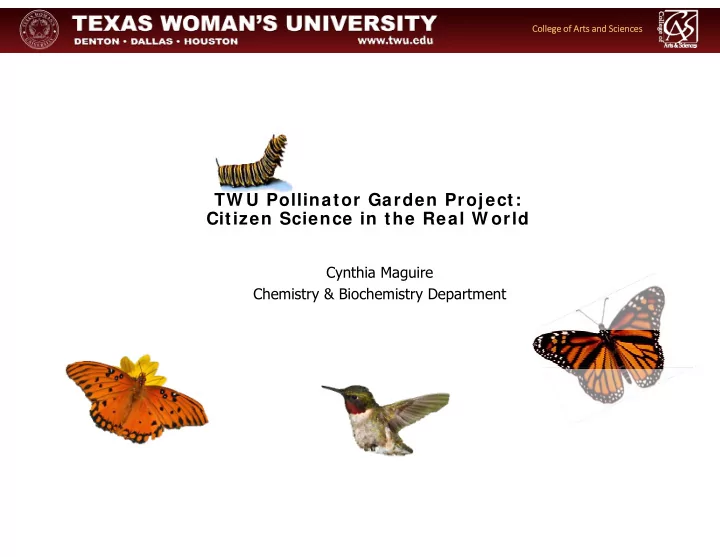

Col Colleg ege of of Ar Arts and and Sc Scienc iences es TW U Pollinator Garden Project: Citizen Science in the Real W orld Cynthia Maguire Chemistry & Biochemistry Department
Col Colleg ege of of Ar Arts and and Sc Scienc iences es TW U Pollinator Garden Project: Citizen Science in the Real W orld Community Partnerships Our partners include the City of Denton Watershed Protection, Beneficial Reuse (composting) and Solid Waste/Recycling departments; Denton Co. Master Gardeners and Master Naturalists; Keep Denton Beautiful; Texas Audubon; and the Native Plant Society of Texas’ Trinity Forks chapter (which meets at TWU) and their statewide Bring Back the Monarchs program. Major Funding from EPA We have partnered with several community agencies and city departments in our SENCER courses through the past decade and more. Now, those partnerships are paying off. The Environmental Protection Agency (EPA) has recently announced they are awarding TWU grant funding of $15K through our People, Prosperity, and the Planet (P3) Phase I proposal, with a possible additional Phase II grant of $75K. They cited our longstanding partnerships as visible evidence of our ability to meet the demands of the project. Curiously, ours was the first pollinator project to request P3 funding.
Col Colleg ege of of Ar Arts and and Sc Scienc iences es TW U Pollinator Garden Project: Citizen Science in the Real W orld Garden Design Phase 1 : Carroll Abbott Mem orial Garden Ann Stuart Science Building NNNNNNNNNNZ Z Z BBBBBBBBB Pollinator garden design and drawings by Carol Feldman, ASLA, of Feldman Design Studios, Dallas, TX
Col Colleg ege of of Ar Arts and and Sc Scienc iences es Garden Design Phase 2 : Bettye Myers Butterfly Garden Pollinator garden design and drawings by Carol Feldman, ASLA, of Feldman Design Studios, Dallas, TX
Col Colleg ege of of Ar Arts and and Sc Scienc iences es TW U Pollinator Garden Project: Citizen Science in the Real W orld Creating Research Opportunities Potential research projects could include studies for a wide variety of courses and disciplines such as history, government, sociology, business and health studies in addition to natural sciences. Examples of likely projects include: ▪ Planting native red yucca and beebalm in the TWU butterfly gardens for pollination studies ▪ Waystations for monarch butterflies in the TWU butterfly gardens ▪ Hummingbird visits to the TWU butterfly gardens ▪ Pollinator visits compared for native plant species and horticultural cultivars ▪ Time of day and pollinator visits ▪ Pollinator visits to native and non-native landscape areas ▪ Runoff water quality before and after passing through the pollinator garden ▪ Water utilization in native vs. non-native plantings ▪ Air quality variations related to plant communities on the TWU campus. Students will keep journals of weather changes and build databases of species in the garden communities. They will present results in local, state and national venues and submit manuscripts for publication in appropriate journals.
Col Colleg ege of of Ar Arts and and Sc Scienc iences es TW U Pollinator Garden Project: Citizen Science in the Real W orld Educational Activities Both curricular and co-curricular educational opportunities abound in this project. Through a variety of class and individual projects, QEP and SENCER activities, and campus-wide student organizations, we will do the following: 1. Conduct garden workdays approximately six times each year to include bed preparation, planting, mulching, pruning, weeding, etc. 2. Conduct plant and animal inventories to build a database, and collect TWU herbarium specimens. 3. Design interpretive signage for each site (graphic arts and science students). 4. Select a native plant in the pollinator garden during the freshman year and investigate that plant and its pollinator relationships throughout a series of chemistry courses including principles of chemistry, organic, analytical and instrumental analysis.
Col Colleg ege of of Ar Arts and and Sc Scienc iences es TW U Pollinator Garden Project: Citizen Science in the Real W orld Acknowledgements This project has been supported by TWU’s Quality Enhancement Plan (www.twu.edu/qep), the SENCER Center for Innovation–Southwest, and donations from faculty and friends of TWU. In addition, we greatly appreciate outside support from the Environmental Protection Agency (grant #SU836774) and the Native Plant Society of Texas through both the Trinity Forks chapter (www.npsot.org/trinityforks) and the Bring Back the Monarchs program (http://npsot.org/wp/monarchs/).
Recommend
More recommend